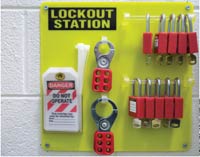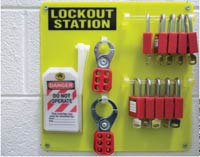
Beware the Sliding Program
Ask point-blank what has slid during a LOTO operation at your facility. You may cringe at the answers.
 Severe burns from steam. Electric
shock. Death when a machine cycles
and a worker is caught and mangled.
Burns. Destroyed and or disrupted lives of
family. Damaged or destroyed equipment.
Lost productivity.
Severe burns from steam. Electric
shock. Death when a machine cycles
and a worker is caught and mangled.
Burns. Destroyed and or disrupted lives of
family. Damaged or destroyed equipment.
Lost productivity.
Add to all of these those dollars by the
thousands that are paid out in worker’s
compensation claims. Yet every day, somewhere,
there is a lockout/tagout program
beginning to slide that will result in some
employee’s being injured or production’s
being adversely affected.
Every employer who has in place a
lockout/tagout program wants to believe
it is used consistently and by each affected
employee. The reality is, for every
employee who knows about LOTO, there
is probably at least one who takes shortcuts
or is not particularly interested in following
it to the letter.
These shortcuts cost big-time in lives,
pain, injury, and damage. Ask point-blank
whether any of these actions has ever slid
during a LOTO operation at your facility:
¦ Failure to train all affected
employees
¦ Failure to use LOTO locks and
devices properly (or at all)
¦ Failure to stop equipment completely
¦ Failure to disconnect from correct
power source in a timely manner
¦ Failure to dissipate (neutralize)
residual energy from system
¦ Accidental restarting of equipment
¦ Failure to clear work areas before
restarting
Safety professionals are stretched to
the limit with so many program priorities
demanding quality time. We train and
then move along to the next deadline. We
assume all is well, and we focus on the
next big project on the list to be done.
The unfortunate news is that LOTO failures
are often invisible until disaster
strikes and your phone rings.
This is a mandate that has been
around for many years, yet it is still regularly
cited by OSHA. It is a standard that
can be hard to understand but works
when used and does save lives—only,
however, when it is followed each and
every time it is needed. The tragic news is
that for every reported death or injury,
there are hundreds and maybe even thousands
of near-misses never heard of.
Some near-misses are communicationrelated
or involve language mishaps from
multilingual crews. Some near-misses
result from ignorance, others from Friday
afternoon “don’t care” attitudes. Still
others are stress-related and associated
with tight work deadlines.
I often explain that LOTO is just
about the best machine guard we have, but
it only works when used.
Hazards of a Sliding Program
You see it a lot: A once-great program
begins to weaken with staff changes,
equipment change-outs, and different
management focus. Live training shifts to
a more static program, and updates
become less frequent. The program is
handed off and assumed by upper management
to work. Others are visited once
a year for training and then not thought
about again.
Talk with your employees and change
the training style to ensure everyone
understands the fundamentals of LOTO.
Retrain where necessary. Bring up different
items on a regular basis in safety
meetings. Share dramatic injuries and
incident details from other facilities with
your employees, because sometimes the
shock factor does help.
Other hazards of a sliding program are time and overworked staff. Beset by constant
deadlines, they may hurry so much
that they do not audit effectively. Safety
officers can burn out from dealing with
such critical issues constantly and be overwhelmed,
in the process failing to recognize
potential problems as quickly as
needed. Other safety professionals become
“desk bound” because of paperwork
demands and fail to get out to the business
end of the facility as often as needed.
Safety has one tough job—overseeing
all of the safety activities of your facility.
Many safety professionals wonder why
they chose this profession as opposed to
something with less stress and more
rewards, but we keep trying to keep our
employees safe nonetheless, knowing the
work we do is vital and life-saving for all
employees. It is your job as a safety pro
and as management to instill in them the
need to use LOTO to protect their lives
by any means available.
This article originally appeared in the March 2008 issue of Occupational Health & Safety.